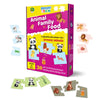What Is Hurried Child Syndrome?
As parents, we all want the best for our children. But in today’s fast-paced, high-achievement culture, many young children are being pushed into a race too soon. Hurried Child Syndrome, a term coined by child psychologist David Elkind, refers to the phenomenon where kids are pressured to grow up too fast—emotionally, socially, or academically—before they’re developmentally ready.
From early academic coaching to jam-packed schedules and digital overload, we may unknowingly rob them of the one thing they need most: a slow, joy-filled childhood.
Signs Your Child Might Be Hurried
Not every busy child is “hurried,” but here are some red flags to watch for:
-
Fatigue or anxiety over daily routines
-
Loss of interest in free play or creativity
-
Emotional outbursts or signs of stress
-
Reduced curiosity or motivation to explore
-
Difficulty in enjoying boredom or downtime
Children need time to be children. When that space is taken away, their natural learning and development can be affected.
Why Slowing Down Matters
Unstructured time isn’t a luxury—it’s a necessity for emotional regulation, cognitive growth, and creative thinking. When kids have time to play freely, explore at their own pace, and follow their interests, they build stronger social skills, better attention spans, and deeper self-confidence.
Childhood is not a race. It’s a process of becoming.
How Parents Can Help
Here are a few simple ways to support a more balanced, child-led pace of life:
-
Avoid Overscheduling: Leave open blocks of time in the day for free play, rest, or simply doing nothing.
-
Limit Screen Time: Encourage offline activities like drawing, puzzles, or reading.
-
Give Space for Emotions: Let kids feel, reflect, and process at their own pace.
-
Let Them Explore Interests Freely: Not every minute needs to be “productive.” Some of the best discoveries come from curiosity-driven play.
Tools That Nurture, Not Rush
At Majestic Book Club, we believe learning should be joyful and natural. Our products are designed to spark curiosity—not pressure. Here are some of the ways we support child-led learning:
-
Board Books & Shaped Sets – Gentle introductions to first concepts, colours, animals, and more.
-
Puzzles – Boost visual reasoning, problem-solving, and memory through play.
-
Sticker Books – Develop focus, fine motor skills, and creativity with interactive learning.
-
Fact Books – Encourage self-paced exploration into animals, inventions, science, and more.
No deadlines. No pressure. Just learning, one joyful moment at a time.
In Our Words
We know parenting is a balancing act. There’s pressure to prepare your child for the future—but we urge you to remember: the greatest preparation is a happy, secure, and confident child.
Let’s not rush them to grow up. Let’s give them the gift of time—time to read, time to wonder, time to just be.








